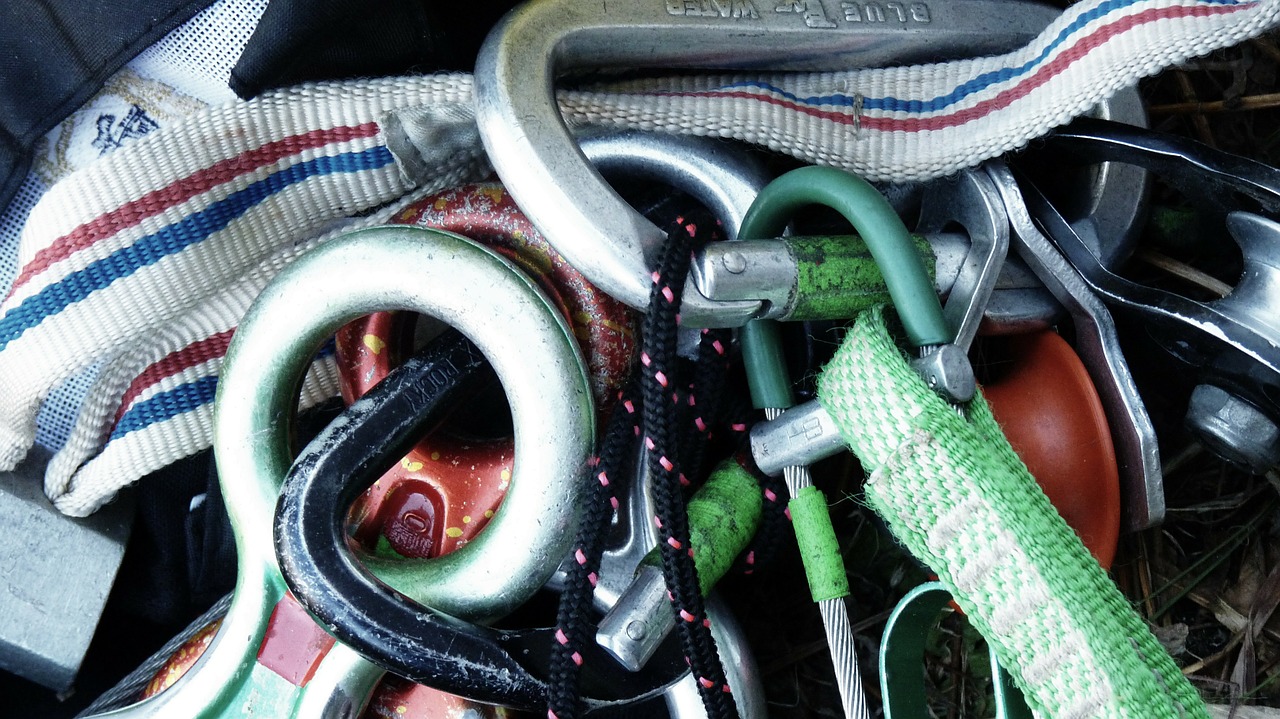Climbing gear for beginners part 2

In part two of ‘Climbing gear for beginners’, we will look at all the less essential gear you will want to start collecting. If you haven’t read part one yet. Start here.
Chalk
Climbing chalk is, in my mind, a necessity. A good grip makes the difference between a send and a long fall down many times. Not only that, but chalk can help keep your hands dry on hot days in the sun.

The brand of chalk is up to you. You can tell the difference between high and low quality chalk, but it is not terribly important.

What you are going to want is a chalk bag that can clip around your waist. If you clip your chalk bag onto your harness it can be hard to access it in different positions. Around your waist, you can slide the bag to anywhere you need it and it stays in an upright position so you can reach into it.
A couple locking carabiners and a personal anchor
These are your lifeline. It is perfectly safe to follow your leader on top rope and let them manage all the climbing gear. However, if anything goes wrong, you are going to want a way to clip yourself in.

Locking carabiners, a couple of slings, or a personal anchor daisy chain are great ways to keep yourself safe. They also become essential when you start learning to help out with putting gear up and taking gear down.

If you want to make your own adjustable personal anchor out of accessory chord, here is a great video about how to make a Purcell-Prusik personal anchor.
A rope

You need a good one, and that can take a lot of research. A lot of factors go into making a good climbing rope. Most climbing ropes are either 60m or 70m long. 60m is enough for most sport climbs, but you will inevitably run into climbs where you’ll either wish you had, or definitely need a 70m. I suggest going 70m from the start for that very reason.

The width of climbing ropes can vary from 8mm to 11mm. Most people climb on ropes that are around 10mm. The thicker the rope, the more of a beating it can usually withstand before it has to be retired. Thicker ropes also allow for easier belaying, lowering and rappelling.
However, they are heavier to haul around and heavier to climb with on tall climbs. Only experience will teach you what width you prefer in your climbing rope.
One other excellent feature that I look for in every rope I buy is a bi-pattern weave. This means that half the rope is one pattern and the other half is another. That way you can always easily find the middle of the rope. This is extremely important when descending from a climb. You’ll learn why when you learn how to rappel.
Quickdraws

Quickdraws or ‘draws’ are the clips that you attach to the bolts in the rock as you go up. The lead climber places draws as they go and clips their rope in. This way, if they fall, they only fall to their last quickdraw and maybe a bit below.
There are a thousand types of quickdraws on the market and all have advantages and drawbacks. They all work perfectly well and you won’t be in danger if you buy cheaper ones.

However, it is important to have some long and some short ones as well as a couple of extendable ‘alpine’ quickdraws. This allows you to accommodate for routes that zig zag back and forth across the rock and keep your rope running as straight up behind you as possible.
So what climbing gear will you get?
Well, in order to get all the gear on this list you will need to be ready to drop hundreds of dollars. It’s no small investment. That’s why I have organized it by importance. Don’t start with a rope and quickdraws. You can borrow those form your friends at first. Once you get better and want to start leading, then you can start thinking about your first rope and a set of draws.

Start with the basics. Get yourself some good shoes, a comfortable harness and some expert training. From there, you are ready to build a solid foundation of skills and gear piece by piece.
Learning to climb takes time and you won’t pick it all up at once. Climbing gear is no different. Gather it bit by bit and before long you will have everything you need. Have fun, enjoy the mountains and always come back safe.
If you have any comments then please drop us a message on our Outdoor Revival Facebook page
If you have a good story to tell or blog let us know about it on our FB page, we’re also happy for article or review submissions, we’d love to hear from you.
We live in a beautiful world, get out there and enjoy it.
Outdoor Revival – Reconnecting us all with the Outdoors
